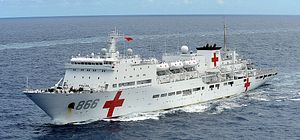The annual Asia Pacific Military Health Exchange took place in Xi’an, China from September 17 to 21. Co-hosted by the Directorate of Medical Services, Logistics Support Department of Central Military Commission, and the United States Pacific Command Surgeon, the conference saw over 500 attendees from 28 countries and three intergovernmental organizations (UN, the International Committee of the Red Cross, and the ASEAN Center of Military Medicine) participating in some 200 academic report sessions.
The Chinese press and the Ministry of National Defense drummed up the Exchange as a testament to China-U.S. military to military friendship in the preceding months; the event was viewed as an important occasion to mitigate Sino-U.S. military relations in a period of mounting tension.
The Exchange was divided into three segments — an academic forum, an exhibition of China’s new military medical equipment, and a tour of Xi’an.
First and foremost, more than 420 papers were presented on wide-ranging topics including but not limited to humanitarian assistance, disaster relief, emerging infectious diseases, mental health, traditional Chinese medicine, and opioid dependency.
Second, participants of the Exchange were given a tour of the People’s Liberation Army’s (PLA) latest medical equipment inventory. The exhibition demonstrated equipment used at the tactical, campaign, and strategic levels. At the tactical level, attendees were shown the PLA’s battlefield first aid equipment, high mobility field ambulance, armored ambulance, medic’s rucksack, orderly’s rucksack, battle station first aid kit, portable stretcher, and combat injury demo dummy. For the campaign level, visitors had the chance to review the PLA’s field hospital system and medical containers, while examining a hospital train, hospital ship, and air ambulances used at the strategic level. In simple terms, the PLA was quite transparent in revealing its newest medical equipment.
Finally, a tour of Xi’an and an evening gala kept the guests entertained throughout their stay.
Interestingly, the Exchange had a surprise guest. General Song Puxuan, director of the PLA Logistics Support Department joined the conference without any prior announcement. A close aide of Chinese President Xi Jinping entrusted with the PLA’s treasury and assets, Song’s arrival highlighted the Chinese leader’s awareness and appreciation of the event.
However, days after the Exchange’s conclusion, it is safe to say that China missed its target in easing tensions with the U.S. military. Just as the forum closed on September 21, Washington slapped sanctions on the PLA’s Equipment Development Department — responsible for the research, development, and acquisition of military equipment — and the Department’s Director Li Shangfu over China’s purchase of Russian Su-35 fighter jets and S-400 surface-to-air missile systems. In response, the Chinese leadership cancelled PLA Navy Commander Shen Jinlong’s scheduled visit to the United States and postponed planned talks in Beijing. Whatever hopes China had in reducing tensions with the Exchange have dissipated with the wind.
Yet beyond the failed outreach to American counterparts, the PLA did achieve a number of goals with remaining participants of the Exchange. The Asia-Pacific, when viewed through a security lens, is a contested area between China and the United States, with Beijing and Washington seeking to raise their influence while undermining that of the other. Although some countries in the region have apolitical militaries, the armed forces of numerous states are not only political, but also incredibly influential.
For example, the military is a powerful institution in a number of ASEAN countries like Thailand, Myanmar, and Indonesia. With bilateral trade totaling $514.8 billion in 2017, ASEAN is China’s fastest growing major trade partner. To be on positive terms with ASEAN states, Beijing has been engaging with actors on all fronts. Building military-to-military relationships is part of the engagement strategy, and we have seen a series of actions taken in military health diplomacy, such as last year’s Peace Train 2017 mission that sought to cultivate ties between the PLA and the Lao People’s Armed Forces through medical exchanges and the PLA’s July 2018 disaster relief expedition in southern Laos.
In contrast to conventional military diplomacy, such as meetings between members of the high command, military health diplomacy reaches a much wider audience of officers, enlistees, and civilians, which is a cost-effective method of planting the seed of lasting goodwill in a large population. In addition, the PLA can build trust and establish new lines of communication with logisticians and military medical personnel, which constitute a unique interest group within respective armed forces.
While the Exchange gave PLA personnel an opportunity to learn about other militaries’ approach in medical work and hear about their latest research, the PLA also had the chance to show off its medical equipment and technology. On the one hand, the PLA seeks to establish itself as a model of military reform through showing its new medical system and capability to its neighbors. On the other hand, such engagements could possibly open up new markets for Chinese-made medical equipment.
In sum, although China missed its primary goal of ameliorating friction between the PLA and the U.S. military, it nevertheless conveyed goodwill between the PLA and militaries from other countries present at the Exchange. As the PLA Navy’s Peace Ark hospital ship docks in Venezuela to provide free medical services to the locals, it looks like health diplomacy carried out by the Chinese military will increase in frequency as the rivalry between China and the United States deepens.
Zi Yang is a Senior Analyst with the China Programme at the S. Rajaratnam School of International Studies (RSIS), Nanyang Technological University, Singapore. Follow him on Twitter @ZiYangResearch.

































